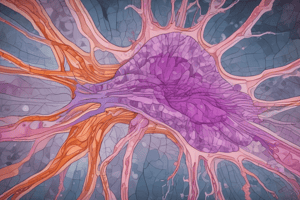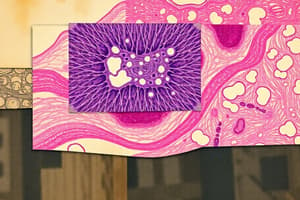Podcast
Questions and Answers
What is the primary purpose of fixation in tissue preparation?
What is the primary purpose of fixation in tissue preparation?
Why are tissues usually cut into small fragments before fixation?
Why are tissues usually cut into small fragments before fixation?
What role does vascular perfusion play in the fixation process?
What role does vascular perfusion play in the fixation process?
Which of the following fixatives is commonly used for light microscopy?
Which of the following fixatives is commonly used for light microscopy?
Signup and view all the answers
How does glutaraldehyde function as a fixative?
How does glutaraldehyde function as a fixative?
Signup and view all the answers
What is the primary purpose of fixation in microscopy?
What is the primary purpose of fixation in microscopy?
Signup and view all the answers
Which chemical is typically used to dehydrate fixed tissue?
Which chemical is typically used to dehydrate fixed tissue?
Signup and view all the answers
What does the term 'clearing' refer to in the tissue preparation process?
What does the term 'clearing' refer to in the tissue preparation process?
Signup and view all the answers
What materials are commonly used for embedding tissues?
What materials are commonly used for embedding tissues?
Signup and view all the answers
What is the main characteristic of fixed tissue after infiltration?
What is the main characteristic of fixed tissue after infiltration?
Signup and view all the answers
What is the primary focus of histology?
What is the primary focus of histology?
Signup and view all the answers
Which of the following statements about tissue preparation is correct?
Which of the following statements about tissue preparation is correct?
Signup and view all the answers
Why are advances in various fields essential for histology?
Why are advances in various fields essential for histology?
Signup and view all the answers
What is a common challenge in preparing microscopic tissue slides?
What is a common challenge in preparing microscopic tissue slides?
Signup and view all the answers
What tools are essential for histology studies?
What tools are essential for histology studies?
Signup and view all the answers
Which characteristic is ideal for a microscopic tissue preparation?
Which characteristic is ideal for a microscopic tissue preparation?
Signup and view all the answers
Which process is NOT typically involved in the preparation of histological samples?
Which process is NOT typically involved in the preparation of histological samples?
Signup and view all the answers
What is a significant reason for the dependence on microscopes in histology?
What is a significant reason for the dependence on microscopes in histology?
Signup and view all the answers
Study Notes
Histology I - Introduction
- Histology is the study of body tissues and their arrangement into organs.
- It encompasses all aspects of tissue biology, focusing on how cell structure and arrangement optimise organ functions.
- Histology relies on microscopes and molecular methods due to the small size of cells and matrix components.
- Advances in biochemistry, molecular biology, immunology, and pathology are vital for a deeper understanding of tissue biology.
- Understanding the tools and methods used within any scientific field is crucial for a comprehensive understanding of the subject.
Histology I - Tissue Preparation for Study
- Tissue slices, or sections, are prepared for visual examination with transmitted light.
- Tissues are usually too thick for light to pass through, so thin sections are cut and placed on slides for examination of internal structures.
- Ideal tissue preparations preserve the same structural features as the tissue in the body.
- Unfortunately, the preparation process can remove cellular lipids and slightly distort cell structure.
Histology I - Tissue Preparation Steps
-
The basic steps of tissue preparation for light microscopy are shown in Figure 1-1(a).
- Fixation: Placing tissue in chemicals to cross-link proteins and inactivate enzymes.
- Dehydration: Transferring tissue through solutions of increasing alcohol concentration, ending in 100% ethanol.
- Clearing: Removing alcohol using organic solvents, making the tissue translucent.
- Infiltration: Immersing tissue in melted paraffin until it is completely infiltrated.
- Embedding: Placing the infiltrated tissue in a mold with paraffin and allowing it to harden.
- Trimming: Trimming the paraffin block to expose tissue for sectioning.
-
Similar steps are used for transmission electron microscopy (TEM), but using different fixatives and dehydrating solutions, and embedding in epoxy resins.
-
Tissue samples for TEM are smaller and require very thin sectioning.
Histology I - Fixation
- Fixation is important because it preserves tissue structure and prevents degradation by enzymes released from cells or microorganisms.
- Tissue samples are placed in fixatives (stabilizing/cross-linking compounds), as soon as possible after removal from the body.
- For large organs, fixatives are introduced via blood vessels (vascular perfusion) for rapid penetration.
- Common fixatives for light microscopy include formalin (buffered solution of 37% formaldehyde).
- Glutaraldehyde is also used as a fixative for electron microscopy because it reacts with proteins, preventing their degradation and reinforcing cell and ECM structures.
- For electron microscopy, tissue is often immersed in buffered osmium tetroxide
Histology I - Dehydration
- The fixed tissue is dehydrated gradually by passing it through a series of increasing concentrations of ethanol solutions, ending in 100% ethanol.
Histology I - Clearing
- Ethanol is replaced by an organic solvent miscible with both alcohol and the embedding medium, a process called clearing.
- This step results in tissue becoming translucent.
- The reagents used in this stage contribute to the translucent appearance.
Histology I - Infiltration and Embedding
- To allow thin sectioning, fixed tissues are infiltrated and embedded in a medium that gives a firm consistency to the tissue preparation.
- Common embedding media include paraffin for light microscopy and plastic resins for both light and electron microscopy.
Histology I - Sectioning
- The hardened block with embedded tissue is trimmed and placed on a microtome for sectioning.
- Paraffin sections are typically 3-10 µm thick for light microscopy (LM).
- Electron microscopy (EM) requires sections thinner than 1 µm.
Studying That Suits You
Use AI to generate personalized quizzes and flashcards to suit your learning preferences.
Related Documents
Description
This quiz covers the fundamentals of histology, focusing on the study of body tissues and their arrangement into organs. It also explores the essential methods and tools used for tissue preparation and examination, crucial for understanding tissue biology and its applications in various fields. Prepare to test your knowledge on these foundational concepts.




